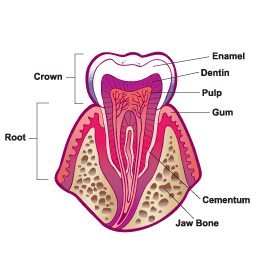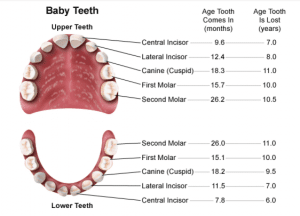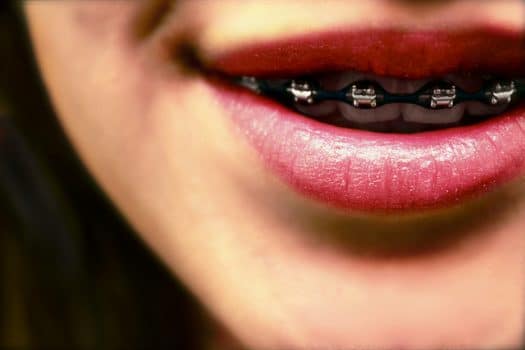The journey to a complete and perfect smile is a long one for humans—most of us will not finish growing our teeth until between the ages of 15 and 25 when our third molars, or wisdom teeth, erupt. During the process of getting braces, your orthodontist will likely make a plan to allow space for these teeth or decide to remove them.
What are Teeth?
You may be surprised to learn that teeth are not bones. Although both are hard, white and comprised of calcium, teeth are not considered bones because they don’t contain collagen. This substance is a living, growing protein tissue that gives bones flexibility to withstand pressure.
However, where bones are superior to teeth regarding flexibility, they fall short in the area of strength. Teeth are in fact the hardest part of the human body. They consist largely of a calcified tissue called dentin (mostly yellow in color), which is coated with enamel—that hard, white layer that you see.
It’s a good thing that teeth are so durable because unlike bones, they lack regenerative properties. When you break a bone, cells inside your body begin immediately filling the gap. But break a tooth and the missing piece is gone forever.
What are the Parts of a Tooth?
 The part of your tooth that protrudes from your gums is called the crown. Its layers are designed to protect the living part of the tooth. Dentin is the layer right below the enamel, and it comprises the largest percentage of your tooth. Though not as tough as enamel, it also is relatively impenetrable.
The part of your tooth that protrudes from your gums is called the crown. Its layers are designed to protect the living part of the tooth. Dentin is the layer right below the enamel, and it comprises the largest percentage of your tooth. Though not as tough as enamel, it also is relatively impenetrable.
The innermost part of the tooth is called the pulp. This is where the tooth’s nerve endings are located. When you experience a toothache or tooth sensitivity, what you really are feeling is the pulp. The pulp travel all the way down to the root of your tooth, which is under the gum. The root is coated with a firm material called cementum.
What Are Primary Teeth?
Your toothless baby actually does have teeth — they just haven’t made their journey through the gums yet. Tooth development began during the neonatal stage, at about six weeks. Three to four months into a pregnancy, the tooth material begins to solidify.
 You can start to see the first signs of a tooth when a child is about six months old. As a general rule, four new teeth grow in about every six months, with lower teeth often developing first. Teeth typically form in pairs—one on the right and one on the left of each type of tooth.
You can start to see the first signs of a tooth when a child is about six months old. As a general rule, four new teeth grow in about every six months, with lower teeth often developing first. Teeth typically form in pairs—one on the right and one on the left of each type of tooth.
However, these teeth are meant to last only temporarily, while larger and stronger permanent teeth continue to develop. Once those teeth are ready and begin their descent through the jaw, primary teeth will fall out to make room for the incoming ones.
Primary teeth are smaller in size and whiter in color than the permanent teeth that will follow.
By the time a child is 2 to 3 years of age, all primary teeth should have erupted. There are fewer primary teeth than permanent teeth, so don’t worry if you count 20. That’s how many there should be.
What are Permanent Teeth?
As you may have noticed, you have teeth of several shapes and sizes. A person’s teeth consist of incisors, canines, premolars, and molars. Molars will be the last teeth to grow in, and many people have their last molars (wisdom teeth) pulled out due to the problems that this set of molars can cause to the jaw and the existing teeth.
The number of permanent teeth is larger than primary teeth — 32, including the wisdom teeth. The first molars usually come through at about age 6 or 7, and by age 13 children should have 28 of their 32 teeth. Permanent teeth are just what their name implies — they can last a lifetime if well cared for, and no future teeth will ever grow to replace them.
What Factors Can Affect the Rate of Growth?
If your baby’s tooth development does not follow within the approximated time frames, it usually is nothing to worry about. In fact, many times slow teething is simply a genetic trait passed down to the child. Babies born prematurely or with low birth weights also commonly experience a delay in tooth development. However, children with no teeth by 18 months should see a dentist to be evaluated for a potential underlying problem.
In rare cases, delayed tooth eruption may be a symptom of genetic disorders such as hypopituitarism or Down’s Syndrome. Nutritional deficiencies also can cause a delay.
At Orthodontic Associates, our expert staff is available to answer any questions about the future development of your child’s smile. Contact one of our nine convenient locations around Baltimore to see how we can help plan a perfect smile.



